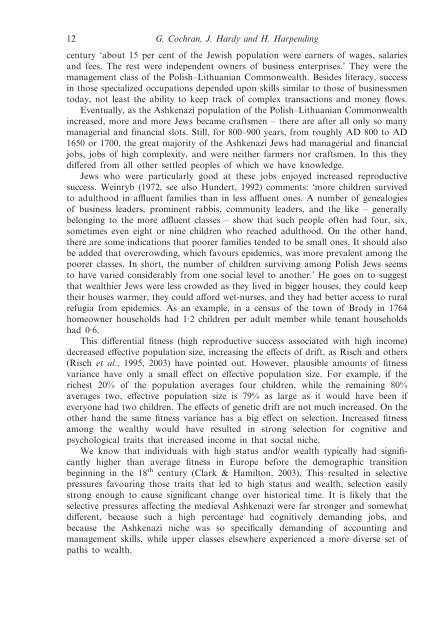natural history of ashkenazi intelligence - Henry C Harpending ...
natural history of ashkenazi intelligence - Henry C Harpending ...
natural history of ashkenazi intelligence - Henry C Harpending ...
Create successful ePaper yourself
Turn your PDF publications into a flip-book with our unique Google optimized e-Paper software.
12 G. Cochran, J. Hardy and H. <strong>Harpending</strong><br />
century ‘about 15 per cent <strong>of</strong> the Jewish population were earners <strong>of</strong> wages, salaries<br />
and fees. The rest were independent owners <strong>of</strong> business enterprises.’ They were the<br />
management class <strong>of</strong> the Polish–Lithuanian Commonwealth. Besides literacy, success<br />
in those specialized occupations depended upon skills similar to those <strong>of</strong> businessmen<br />
today, not least the ability to keep track <strong>of</strong> complex transactions and money flows.<br />
Eventually, as the Ashkenazi population <strong>of</strong> the Polish–Lithuanian Commonwealth<br />
increased, more and more Jews became craftsmen – there are after all only so many<br />
managerial and financial slots. Still, for 800–900 years, from roughly AD 800 to AD<br />
1650 or 1700, the great majority <strong>of</strong> the Ashkenazi Jews had managerial and financial<br />
jobs, jobs <strong>of</strong> high complexity, and were neither farmers nor craftsmen. In this they<br />
differed from all other settled peoples <strong>of</strong> which we have knowledge.<br />
Jews who were particularly good at these jobs enjoyed increased reproductive<br />
success. Weinryb (1972, see also Hundert, 1992) comments: ‘more children survived<br />
to adulthood in affluent families than in less affluent ones. A number <strong>of</strong> genealogies<br />
<strong>of</strong> business leaders, prominent rabbis, community leaders, and the like – generally<br />
belonging to the more affluent classes – show that such people <strong>of</strong>ten had four, six,<br />
sometimes even eight or nine children who reached adulthood. On the other hand,<br />
there are some indications that poorer families tended to be small ones. It should also<br />
be added that overcrowding, which favours epidemics, was more prevalent among the<br />
poorer classes. In short, the number <strong>of</strong> children surviving among Polish Jews seems<br />
to have varied considerably from one social level to another.’ He goes on to suggest<br />
that wealthier Jews were less crowded as they lived in bigger houses, they could keep<br />
their houses warmer, they could afford wet-nurses, and they had better access to rural<br />
refugia from epidemics. As an example, in a census <strong>of</strong> the town <strong>of</strong> Brody in 1764<br />
homeowner households had 1·2 children per adult member while tenant households<br />
had 0·6.<br />
This differential fitness (high reproductive success associated with high income)<br />
decreased effective population size, increasing the effects <strong>of</strong> drift, as Risch and others<br />
(Risch et al., 1995, 2003) have pointed out. However, plausible amounts <strong>of</strong> fitness<br />
variance have only a small effect on effective population size. For example, if the<br />
richest 20% <strong>of</strong> the population averages four children, while the remaining 80%<br />
averages two, effective population size is 79% as large as it would have been if<br />
everyone had two children. The effects <strong>of</strong> genetic drift are not much increased. On the<br />
other hand the same fitness variance has a big effect on selection. Increased fitness<br />
among the wealthy would have resulted in strong selection for cognitive and<br />
psychological traits that increased income in that social niche.<br />
We know that individuals with high status and/or wealth typically had significantly<br />
higher than average fitness in Europe before the demographic transition<br />
beginning in the 18 th century (Clark & Hamilton, 2003). This resulted in selective<br />
pressures favouring those traits that led to high status and wealth, selection easily<br />
strong enough to cause significant change over historical time. It is likely that the<br />
selective pressures affecting the medieval Ashkenazi were far stronger and somewhat<br />
different, because such a high percentage had cognitively demanding jobs, and<br />
because the Ashkenazi niche was so specifically demanding <strong>of</strong> accounting and<br />
management skills, while upper classes elsewhere experienced a more diverse set <strong>of</strong><br />
paths to wealth.


